Sedum Burrito - all stages of care
A succulent plant with an original appearance and an unusual name - sedum, or sedum, Burrito - is widely used in decorative home gardening. It is often used as a component in various compositions, in combination with brighter representatives of the flora, in the form of a "carpet" plant in winter gardens, in small gardens among stones, etc. It is one of 600 species of the Tolstyankov family. Lives in Europe, on both American continents, in Africa, Asia.
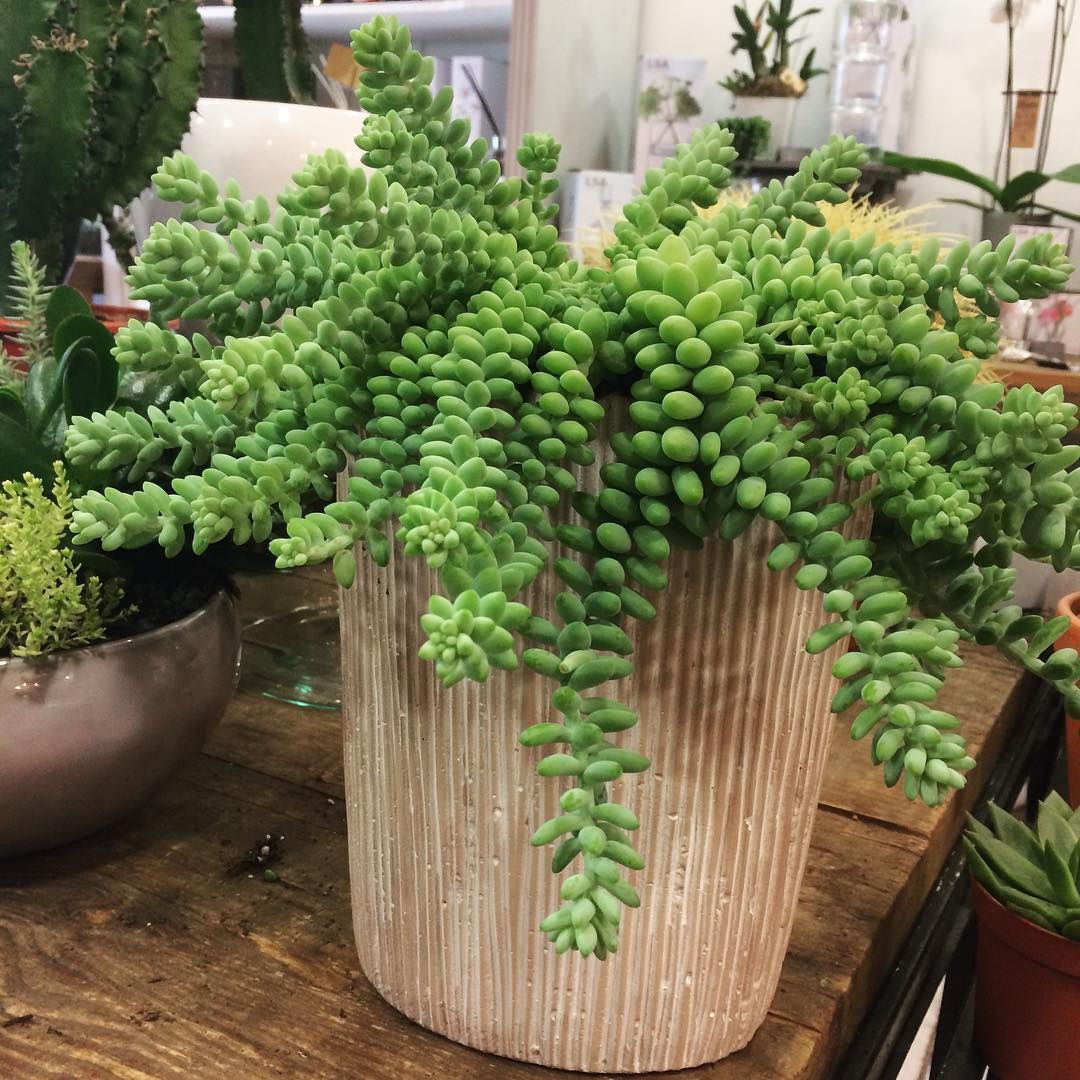
Sedum Burrito
Plant characteristic
Sedum Burrito is an evergreen herbaceous perennial plant with an ampelous growth pattern.
In nature, it most often grows in mountainous areas with a dry climate.
Important! Wax plaque cannot be removed from the leaves. This can lead to his illness.
Appearance Description:
- Stems. There are a large number of them on the flower. Semi-lignified, spreading or hanging down. The average shoot length is from 20 to 30 cm, but they can grow up to 1 m in length.
- Leaves. Without petioles, spherical. They reach a length of 1-2 cm. Fleshy, green. Covered with a wax-like coating that retains moisture in the succulent. They densely frame the stem, but they do not hold tightly - they can crumble under any mechanical stress.
- Flowers. Appear in late spring. In shape, they resemble light pink bells.
- Roots. The root system is superficial, horizontal, which should be taken into account when transplanting a plant.
Purchase and adaptation
In order for the purchased succulent to be strong, viable and fresh, it is advisable to buy it from a new, recently arrived batch.
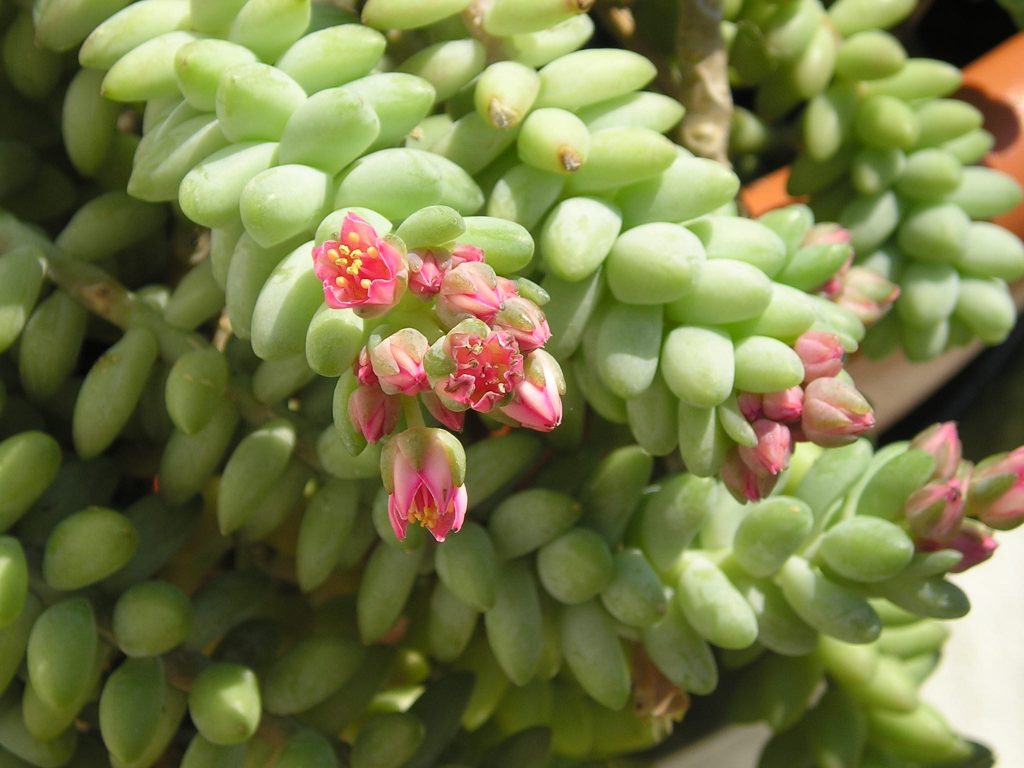
Sedum burrito
Take a close look at the leaves - they should be dense, fleshy, with a waxy coating, adhere well to the stem (however, do not tug at them to check this). The plant should be free of parasites, rotten areas.
Flowers are sold in a special shipping medium. Usually it is coconut or peat with a special feeding system and hydroponics. It is not suitable for permanent cultivation:
- during the transportation of sedum (another name for sedums) and being in the store, it manages to use up the supply of nutrients in the soil;
- the flowers become cramped in the container in which they are planted.
Therefore, it is necessary to transplant into soil that meets the needs of the plant's root system. The following signs will indicate the need for a procedure:
- An empty space formed between the earthen ball and the sides of the pot. When watering, water flows into it, leaving the roots of the flower dry. The plant loses full moisture.
- The roots of the succulent protrude through the drainage holes. This indicates the complete filling of the soil in the container with the root system.
- The size of the ground part of the flower is several times the size of the pot in which it is planted. It also indicates that the container for the plant has become small.
You should not transplant the purchased succulent into a new pot immediately after purchase. It is advisable to wait from 3-5 days to 2-3 weeks (depending on the condition) for the plant to adapt.
Place the container so that direct sunlight does not fall on the leaves, water regularly.
Recommendation: After the purchase, place the purchased succulent in a separate "quarantine" room, in order to avoid contamination of other domestic plants with insects and diseases that the beginner may have.
Landing rules
Due to the unpretentiousness of stonecrop, its planting does not require much effort from the grower. The most important are the correctly chosen place for the placement of the flower and the composition of the soil.
A succulent substrate is ideal. You need to add to it:
- brick chips;
- charcoal;
- clean river sand.
The ingredients are taken in equal amounts. Their ratio to the substrate is 1: 2.
The best location is the south-facing windows. It is desirable that there are no curtains on them, there are no other plants covering the flower with sunlight - stonecrop does not really like strong shade.
The necessary conditions
For the best growth, development and flowering of sedums, it is necessary to create suitable conditions. We need levels of humidity, temperature, and illumination that are optimal for the plant.
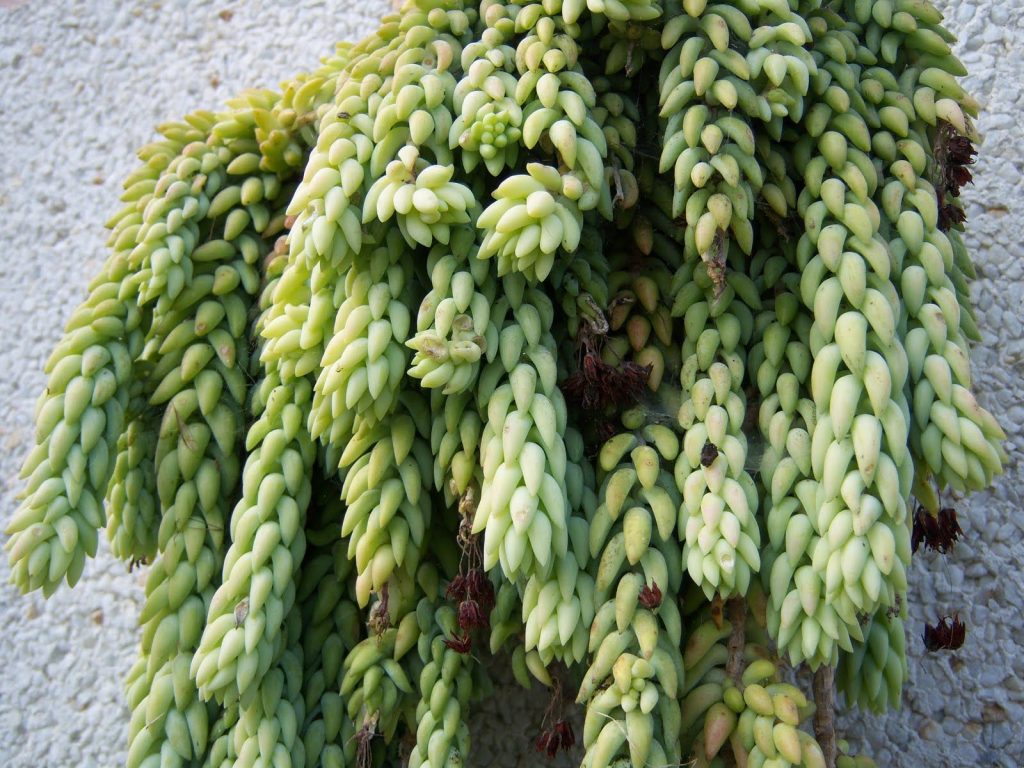
Potted flower sedum burrito
Humidity
The culture is indifferent to the crown spraying procedure. She needs dry air, since with high humidity, rotting of leaves and stems is possible. To prevent room dust from accumulating on the flower, he periodically needs to arrange a shower with warm water.
Temperature
The most suitable temperatures for sedum are:
- in summer - from + 25 ° C to + 28 ° C;
- in winter - from + 8 ° C to + 12 ° C.
Higher rates in summer are fraught with the loss of the plant's lower leaves, and in winter, even the death of the flower.
Tip: in winter, try not to open the window on which the sedum pot is located, in order to avoid freezing.
Lighting
The plant needs to provide a sufficient amount of sunlight. With its lack:
- internodes begin to lengthen;
- the stems become thinner;
- the decorative appearance of the flower is lost.
In winter, additional lighting is needed. Well suited for her: LED phyto-lamps, fluorescent lamps.
It is possible to create a light source by combining lighting with an 18-watt fluorescent lamp and a 25-watt incandescent lamp.
Care
Competent plant care involves feeding on time, timely and sufficient watering, transplanting according to the rules and at the right time.
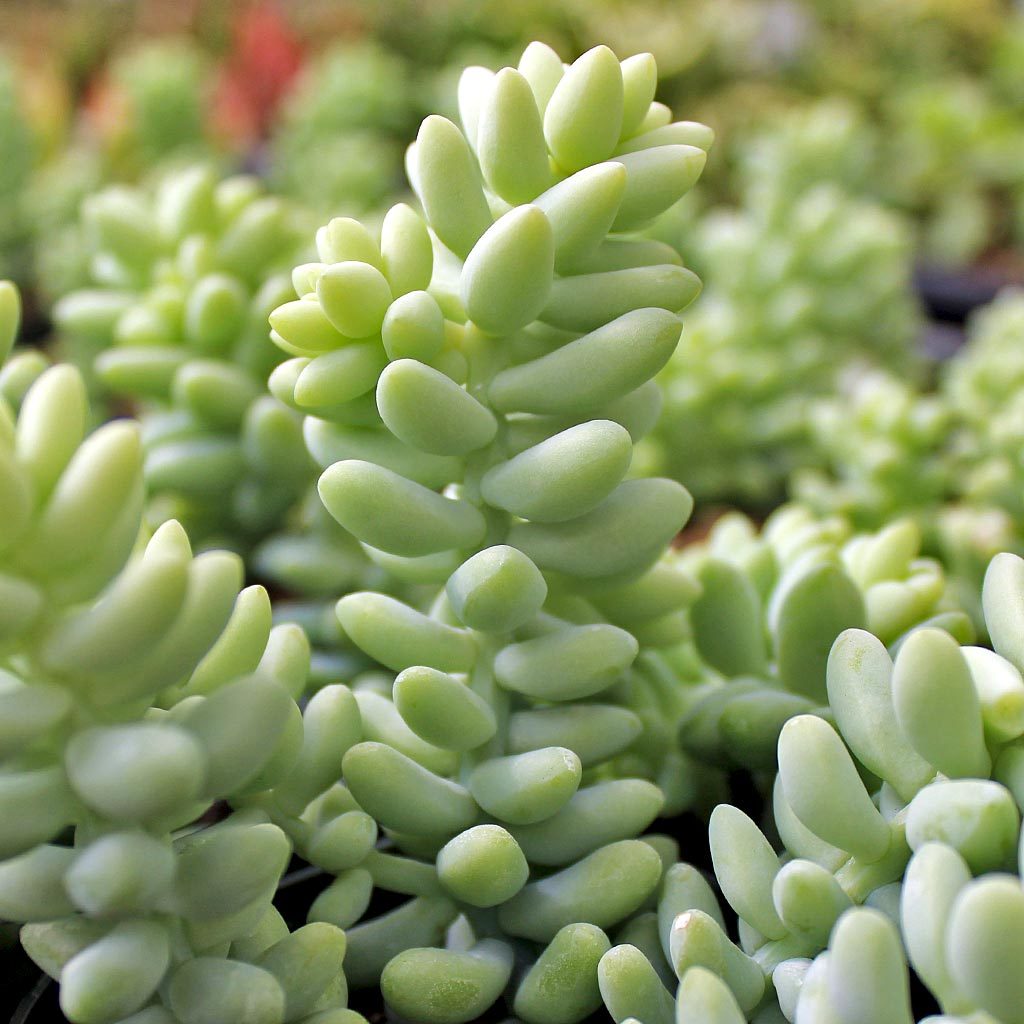
Sedum burrito
Top dressing
To feed the flower, organic fertilizers are used for cacti and succulents. They are applied once a month during periods of intensive growth: in the spring and summer months, before and after flowering. Sedums are not fertilized in autumn and winter.
Information: mineral dressings are not used, because they cause the plant to lose its decorative effect.
Watering
Sedums have the ability to accumulate moisture, therefore, they do not tolerate excessive watering, stagnant water. They are rarely watered, only when the soil is completely dry. At the same time, they take the water at room temperature.
Transfer
The transplant must be carried out not only after the purchase of sedum in the store. It is also needed by:
- overgrown young bushes;
- mature plants;
- flowers infected with diseases or harmful insects.
Young plants are transplanted once every 2 years, adult bushes - once every 3-4 years, sick perennials attacked by pests - immediately after the problem is detected.
Important! The transplant should be carried out very carefully - the leaves are fragile, easily break off from the stem. The exposed parts of the plant do not look aesthetically pleasing.
You can transplant flowers all year round, with the exception of the flowering period. The most optimal are:
- 2 first spring months - March, April.At this time, daylight hours increase, as a result of which all vegetative processes are activated, the flower adapts better to a new pot.
- In the fall, in the winter. Metabolic processes slow down, damage to individual roots during transplantation does not negatively affect the state of the plant, which helps to reduce its stress.
The pot should be used wide and low - the stonecrop root system is small, horizontal type.
Reproduction methods
Sedum can be propagated in several ways: by seed, cuttings, or by dividing an adult plant. They all have their own characteristics.
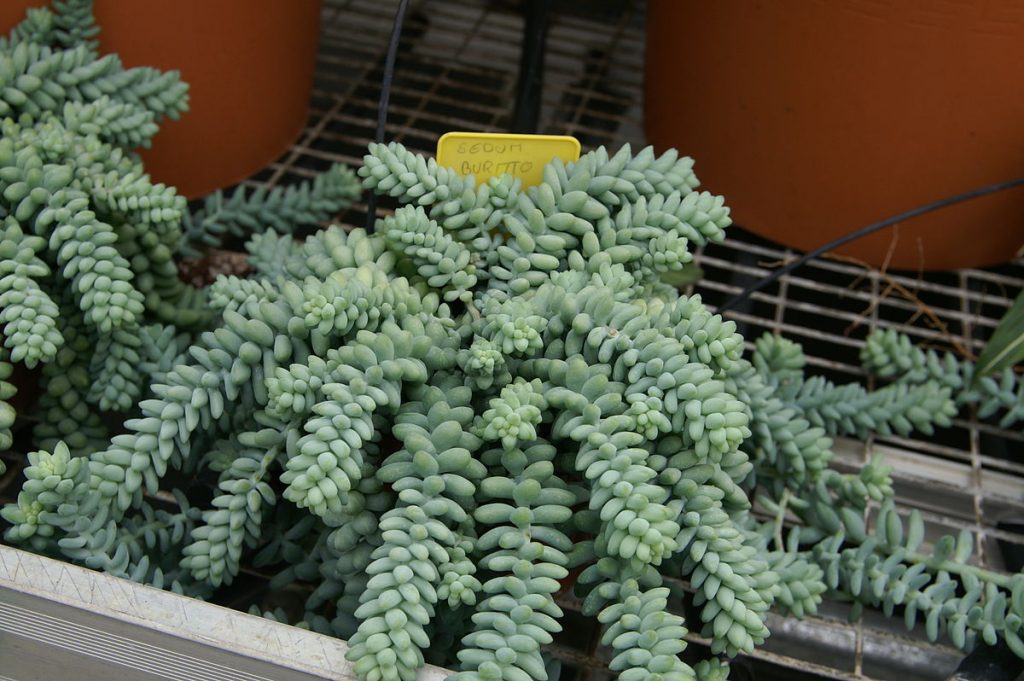
Sedum burrito breeding
Seeds
It is quite simple to propagate stonecrops by seeds. Planting seeds for seedlings is carried out from the first days of March to the last days of April.
You need to do the following:
- fill a small container with soil;
- spread seeds on its surface;
- water them;
- cover the container with plastic wrap;
- put the container on the lower shelf of the refrigerator, where the temperature is between 0 ° C and + 5 ° C;
- after 14 days, remove the container from the refrigerator and place it in a room with an air temperature from + 18 ° C to + 20 ° C;
- periodically moisten the soil moderately.
If all actions are performed correctly, shoots should appear in about 1 month. When the first 1-2 leaves are formed on them, the seedlings dive into the pots, into the previously loosened and moistened soil.
In the center, a recess is made into which seedlings are planted, then sprinkled with soil and watering is carried out.
Immediately after planting, the pots are kept in a darkened room. As the seedlings grow, the containers are transferred to a brighter room.
Information: a perennial growing at home needs regular ventilation and proper watering. Compliance with these conditions leads to rapid rooting of the plant.
Cuttings
Reproduction in this way is performed in the following order:
- remove the lower leaves from the selected cutting;
- place in a pot or in previously leveled and weed-free soil on the site, deepening the cutting by about 2 cm;
- lightly compact the earth around the planting material;
- water, provide shading.
The soil must be watered regularly, avoiding drying out. After 1 month, the planted cutting should give roots. This will be indicated by the young sprouts that have appeared on it.
Cuttings that have taken root are transferred with an earthen clod into a permanent container or onto a land plot.
By dividing an adult plant
The method consists in digging a bush earlier in the spring and dividing it into several parts. Optimally - 3-4. Each part should have a bud of growth and a share of the root system.
Places of cuts are treated with fungicides. The separated parts are planted in the wells. The size of the pits is made based on the volume of the rhizome.
Diseases and pests
Sedum is quite resistant to various diseases, but sometimes they are still shown to be susceptible to them.

Sedum burrito care
- Decay of roots. It can be indicated by the appearance of dry brown spots on the foliage, especially in autumn and winter. The reason is excessive watering, stagnation of water in the pot. It is necessary to reduce the number or amount of waterings.
- Elongation of stems, increasing the distance in internodes. The reason is the lack of light. It is necessary to place a pot with a plant on a window overlooking the sunny side, provide flowers with artificial lighting.
- Falling leaves, their lethargy, wrinkling, yellowing. Insufficient hydration is the cause. It is necessary to increase the number of waterings.
- Loss of lower leaves, bare stems at the base. When grown outdoors - blackening of sedum. It occurs due to the presence of perennials in drafts, in conditions with too low temperature indicators.
Most of all, the plant suffers from mealybugs, which are located in the axils of the leaves. They inhibit growth, worsen the appearance, and can lead to the death of the succulent.
Method of control: treatment with special chemical and biological insecticidal agents, calcining the earth before using it in the oven, steaming it in a water bath (pests do not tolerate high temperatures).
Sedum Burrito is an original perennial decorative culture. With good care, it will give the florist aesthetic pleasure, a favorable atmosphere in the house, and a good mood.

